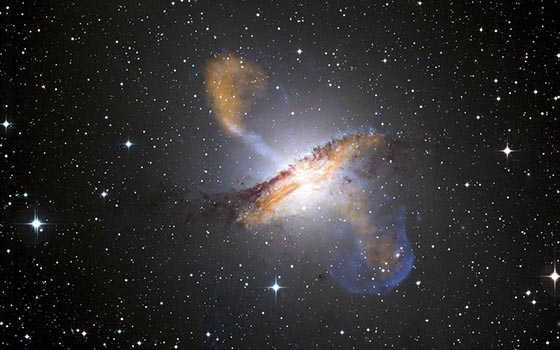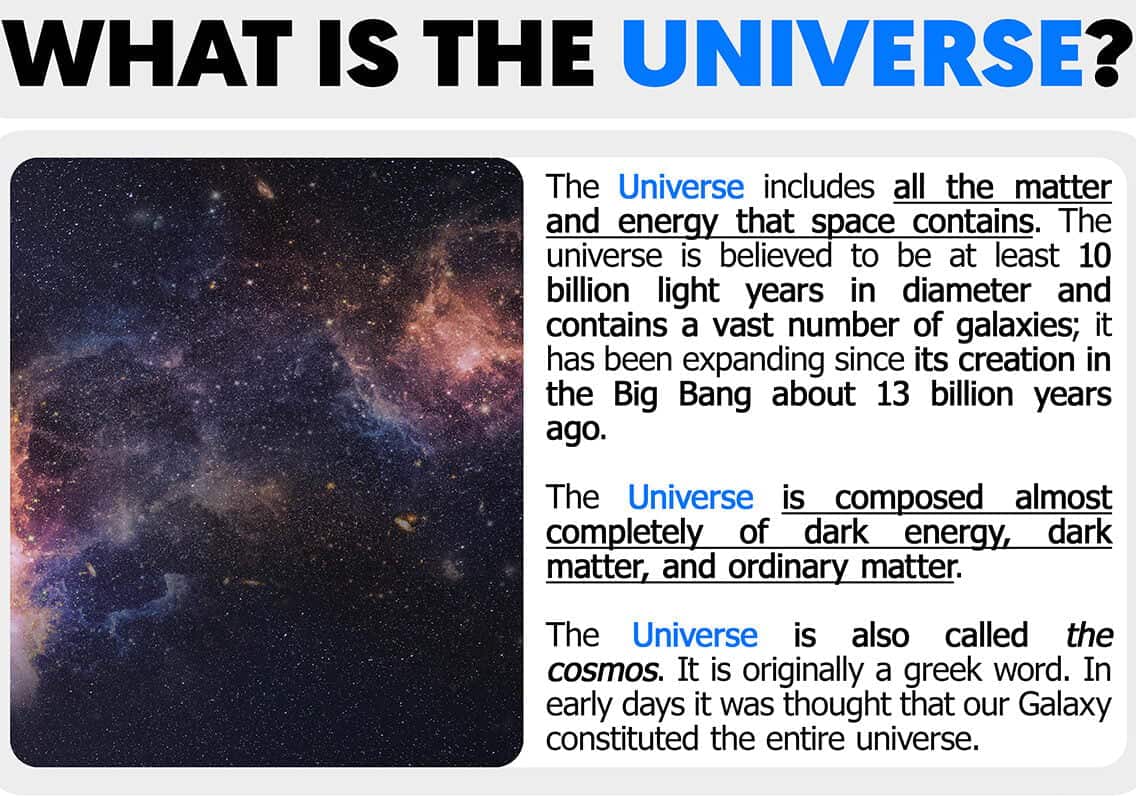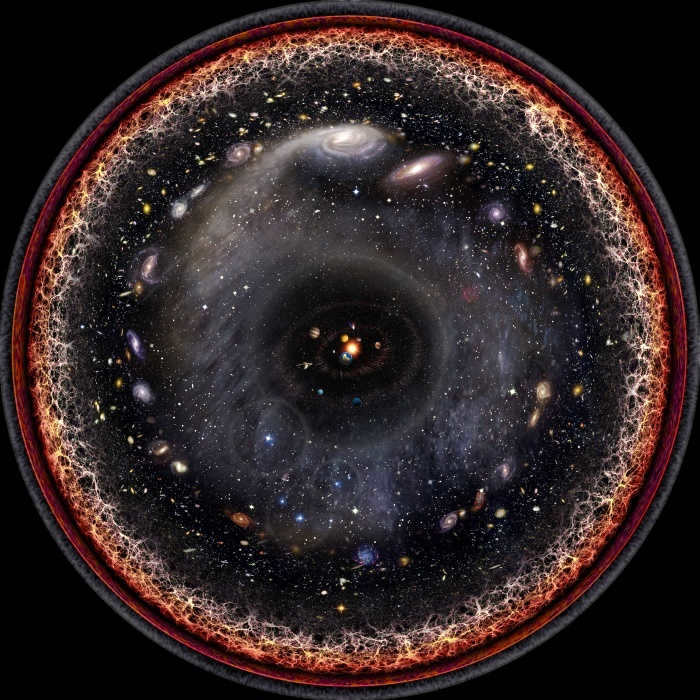
When we observe the edges of the visible cosmos, we are effectively peering into the past. Since it took 13.7 billion years for light to travel to us, we are witnessing the universe as it existed 13.7 billion years ago, rather than its present state.
The entire universe is likely infinite in size. While this statement is simple to make, comprehending the concept can be quite challenging. One way to approach this dilemma is to suggest that we need not concern ourselves with it. If you find yourself pondering questions like “how can something infinite expand,” you are misunderstanding the nature of infinity. Infinity is a concept, not a numerical value.
However, it is also possible for the universe to be finite. In accordance with the theory of General Relativity, there exist other possibilities. I will categorize them into two groups, but we will only delve into one of them in depth.
Fascinating configurations
There is a chance that the universe possesses intriguing configurations. Configuration differs from geometry. Geometry encompasses aspects such as the lengths of lines, radius of curvature, sums of angles in polygons, and so on. On the other hand, configuration focuses on the interconnectedness of various regions in space.
Take, for instance, the well-known game Asteroids:

The game is set in a compact two-dimensional world. The structure of the Asteroids universe is Euclidean in nature, meaning that parallel lines never intersect and the ratio of a circle’s circumference to its diameter is always π. Additionally, the sum of the interior angles of any given triangle will always be 180°. However, if you’ve ever played the game, you’ll know that if your character ventures off the left side of the screen, they will reappear on the right side. The same applies to the top and bottom edges of the screen. The universe itself has no boundaries, so you’ll never encounter an actual edge or boundary. However, it is finite in size. Its topology is toroidal, similar to the surface of a bagel, although its geometry differs from that of a bagel (as a bagel’s surface is curved).
Therefore, at present, we will acknowledge the fact that the universe lacks any fascinating topologies. It is either an infinite expanse or a finite expanse, akin to the three-dimensional counterpart of a spherical surface.
Viable geometries of the universe
The universe’s geometry does not necessarily adhere to Euclidean principles. Depending on the aggregated energy density (encompassing the densities of regular matter, dark matter, and dark energy), three potential curvatures exist for the universe.
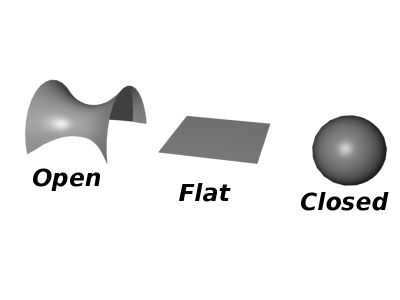
The Ω parameter serves as a convenient means of discussing the density of the Universe. A critical density exists, dependent upon the current rate at which the Universe is expanding, which is 9*10 -30 g/cm. While this may not appear significant, it is important to consider that the Universe is largely empty. In comparison, Earth is relatively dense when compared to the majority of the Universe. The Ω parameter is defined as the ratio of the Universe’s density to the critical density. If Ω = 1, it indicates that the universe has a flat geometry. By “flat,” it is not referring to two-dimensionality in the way you might think of a plane. Instead, it signifies that the space’s geometry is Euclidean, similar to the geometry taught in school.
If Ω>1, the universe’s geometry is closed. In this scenario, the universe’s geometry would resemble the three-dimensional surface of a four-dimensional hypersphere. To put it in simpler terms, it’s like the three-dimensional version of a sphere’s surface. The four-dimensional hypersphere doesn’t necessarily have a fourth spatial dimension. What this means is that the universe’s geometry – how parallel lines behave, the sum of angles in a triangle, or the ratio of a circle’s circumference to its diameter – is the same as the geometry on a sphere’s surface. We can describe the math behind this geometry using only three spatial dimensions, so higher dimensions may not be required. However, for the sake of understanding, it’s helpful to visualize the surface of a sphere, as it gives us an idea of the structure of such a universe. The surface of a sphere represents a closed two-dimensional universe. Remember that the universe is a surface and doesn’t have a center. It doesn’t exist within the universe, as everything it contains is on the surface of the sphere, and all its points are the same.
The Universe’s Geometry
Discovering the geometry of our universe can be achieved through various methods. One such method involves constructing a triangle using three straight lines in space. The next step is to measure the angle between each pair of lines. If the sum of these angles equals 180°, then you are in a flat universe. If the sum exceeds 180°, then it is a closed universe. Conversely, if the sum is less than 180°, then it is an open universe. However, the accuracy of these measurements poses a challenge. Either one must measure these angles with exceptional precision or draw extremely large triangles where one side’s length approximates the radius of curvature of the universe. The level of approximation depends on the angle measurement’s accuracy.
The Smallest Possible Size of Our Universe
The universe is vast. It is incredibly immense. You can’t even fathom how unbelievably gigantic it is. You might consider the distance from your home to the pharmacy to be significant, but that pales in comparison to the scale of the cosmos.
We must extend our apologies to Douglas Adams and endeavor to determine the precise dimensions of our universe.
To begin with, the age of the Universe is 13.8 billion years. That’s a considerably lengthy period in comparison to our individual lifespans, but for the Universe, it is a rather respectable age. The boundary of the observable Universe is situated 48 billion light years away. “Hold on a moment!” you may exclaim. “How is it possible for light to traverse a distance of 48 billion light years in just 13.8 billion years!”. Keep in mind that while light was journeying towards us, the universe was undergoing expansion. In a way, light was endeavoring to “keep pace” with this expansion. This is not a flawless explanation and if you are acquainted with STO, you may raise objections. However, it does offer some degree of coherence within the framework of GR.
What is the connection between this size and the overall size of the universe? Assuming that Ω=1.0133, which represents the highest energy density supported by current data and therefore the smallest of the closed universes, we can determine the universe’s size. The outcome can be presented as follows:
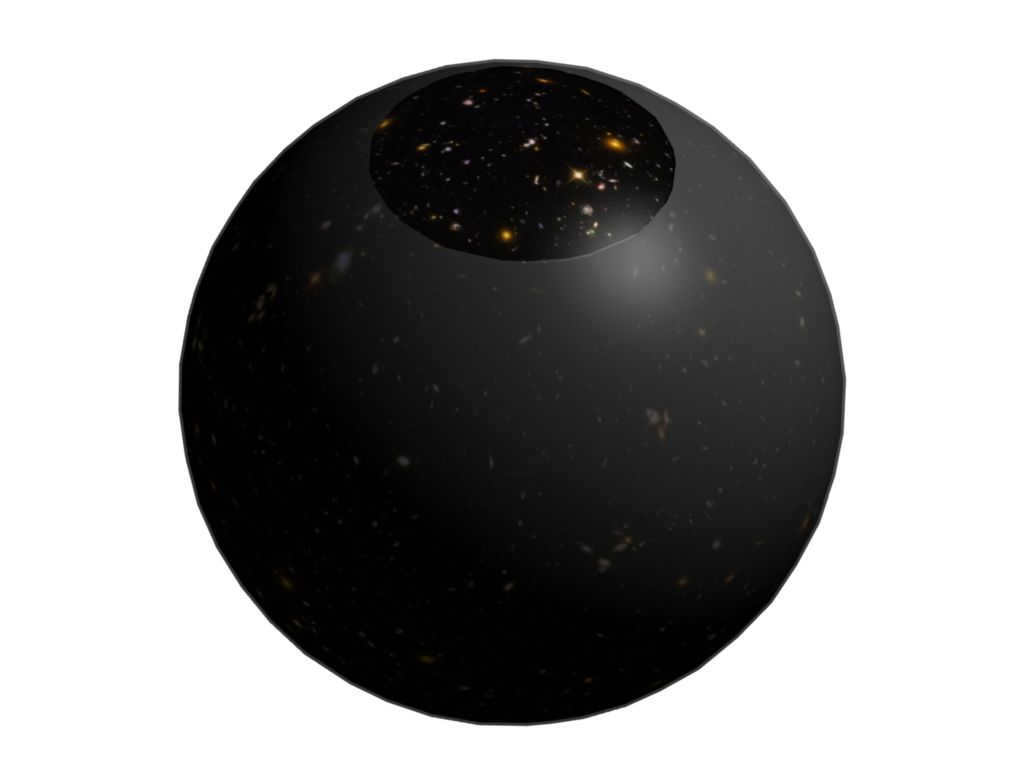
The size of the entire universe can be represented by the surface of a sphere, where Ω=1.0133. The part of the sphere that appears matte is beyond what we can observe, while the visible portion represents our observable universe. The universe has a radius of curvature of 120 billion light years and a circumference of 760 billion light years. This means that the diameter of the observable Universe is only 1/8 of the total length needed to close the space. The volume of the entire universe is 100 times greater than the volume of the observable universe. (It’s important to note that in our non-Euclidean space, the relationship between radii and volumes is different from what our intuition might suggest).
There is no correlation between size and destiny
If you open any book on cosmology written before 2000 (and some slightly newer ones), you will likely find the assertion that a closed universe is collapsing inward while an open universe is expanding indefinitely. However, this is only true if the density of dark energy in the universe is zero! These statements implicitly assume that our universe is primarily composed of matter, in which case the geometry and destiny of the universe are closely intertwined. In a universe like ours, where dark energy exists, the relationship between destiny and geometry is not as strong. Dark matter and dark energy both influence the shape and destiny of the universe, but they do so in different ways. The ultimate fate of our universe depends on the nature of dark energy. However, if dark energy behaves as most scientists believe it does, the universe will continue to expand indefinitely, causing galactic clusters to become more and more dispersed. Whether our universe is flat, open, or closed becomes inconsequential.
The concept of the universe is a fundamental idea in the field of astronomy, which does not have a strict definition [1] [2] [3] [4]. It encompasses the entirety of the surrounding world. In practical terms, the universe is often considered to be a portion of the material world that can be studied using natural scientific methods. The age of the universe refers to the time that has elapsed since its initial expansion.
The astronomical universe or metagalaxy is the portion of the universe that is currently observable or can be observed in the foreseeable future.
The Universe’s “age”, as per recent findings [5], is approximately 13.72 ± 0.12 billion years. However, some scientists hold the belief that the Universe did not have a beginning but has existed eternally and will continue to do so, undergoing only changes in its forms and manifestations. The scientific community also engages in intense debates regarding the shape and size of the Universe. It is presumed that the spatial expanse of the Universe, in terms of constant synchronous proper time (i.e., the time elapsed since the Big Bang), is at least 93 light years [6] [7].
The Great Wall of Sloan and the Great Wall of CfA2 are the largest known structures in the Universe, and the most remote astronomical object ever detected is a gamma-ray burst that occurred 13 billion years ago.
Word formation [ ]
In the Russian language, the term “Dr. Greek οἰκουμένη” is traditionally translated as “Universe” or “inhabited Universe,” although in ancient Greek it means ” [8] .”
Observations [ ]
Of course, any observation, whether it’s a child watching a cat, a nuclear physicist observing a proton split, or an astronomer making observations of a galaxy far, far away, all of these are observations of the Universe, or more precisely, of its individual components.
However, it is crucial to observe and study large-scale structures, objects, and processes in order to gain a comprehensive understanding of the Universe as a whole. Currently, astronomers working in this field are primarily focused on two main areas:
- Exploring the history of the Universe from its early stages to the present day.
- The measurement of cosmological distances and the correlating principle of the expansion of the Universe.
It is important to acknowledge that the majority of our knowledge about the Universe is derived through indirect means. Typically, assumptions are formulated and subsequently tested.
Distance Measurement and Cosmological Redshift [ ]
The scale of the surrounding cosmos has been a topic of intense investigation for astronomers since the time of Galileo. Prior to the early 20th century, the scope of our known world was relatively small. It was not until Edwin Hubble’s groundbreaking discovery that the vast expanse of the Universe was confirmed. Concurrently, it was determined that:
- All distant galaxies are in a state of motion away from us.
- As the distance between us and these galaxies increases, their rate of departure accelerates.
The principle of expansion is described by Hubble’s law, which states that V=H0r, with H0 being a constant now known as the Hubble constant.
The widely accepted interpretation of this phenomenon is that we are witnessing the Universe’s expansion. However, this view is challenged by the photon aging theory and the APC theory. Nonetheless, there are very few proponents of these alternative theories, largely due to the lack of substantial observational evidence.
Hubble’s groundbreaking discovery would not have been possible without the establishment of the initial steps of the distance ladder. At the core of this ladder is the trigonometric parallax method, which is the only direct and model-independent technique available to astronomers for determining distance. All other methods rely either on indirect measurements or on specific models.
Method of determining parallax using trigonometry [ ]
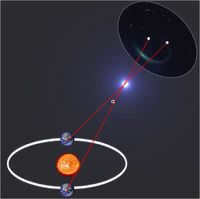

The annual parallax represents the angle at which the mean radius of Earth’s orbit is observed from the star’s center of mass. The presence of the annual parallax is solely determined by the principles of geometry and nothing else. Therefore, this technique is similar to using a ruler and is not dependent on any specific model. According to the same principles of geometry, the distance to the star can be calculated as follows:
However, in practice, this approach is not commonly used, as sin α is approximated as α. The final formula employed in practical applications is as follows:
Here, the angle α is measured in radians. As the distance to the star increases, the value of parallax decreases, which significantly limits the method’s applicability.
Cepheids and RR Lyrae stars are types of variable objects. While cepheids are young objects, RR Lyrae stars are already evolved from the main sequence and are giants of spectral classes A-F. One characteristic feature of these stars is the relationship between their pulsation period and their absolute stellar magnitude.
This method has two main challenges:
- The low luminosity of these objects makes it extremely difficult to identify a Cepheid in a distant galaxy.
- It is necessary to account for light absorption by dust when calibrating dependencies and measuring distances.
The technique for calculating the distance from supernovae of type Ia
Supernovae of type Ia occur when a white dwarf in a close binary system explodes. By using measurements of cepheid variables, scientists have determined that all supernovae of this type have a similar level of brightness at their maximum.
The process behind this phenomenon is quite straightforward: as matter from the companion star accumulates on the surface of the white dwarf, its degenerate gas reaches a point where it can no longer support the weight of the accumulated matter, causing a collapse. The mass of the white dwarf at this moment is known as the Chandrasekhar limit. The uniform luminosity at maximum is believed by theorists to be a direct result of this fact.
Then, if you capture the burst of light when it is at its brightest, you can calculate the distance to the supernova. Additionally, by analyzing the lines in the spectrum, you can determine the redshift. Following a similar course of action, in 1998, two groups of researchers made the groundbreaking discovery of the Universe’s accelerating expansion.
The technique for determining distance using gravitational lensing [ ]
When a beam of light passes near a massive object, it is bent. This allows the massive object to focus and collect the parallel beams of light, creating multiple images. The time delay between these images, in most cases, can be approximated as tdel = d/c, where d represents the distance between the images and c is the speed of light.
By utilizing the laws of geometry and taking into account the angular distance between the images, it is possible to calculate the distance to the lens. Nevertheless, the drawback of this approach is that the gravitational potential and structure of the lens are not known beforehand. This lack of prior knowledge can introduce a notable margin of error in precise measurements.
The most luminous red giants exhibit an identical absolute stellar magnitude (-3.0 m ±0.2 m). This phenomenon was initially documented by Sandage in 1971. It is postulated that these stars exist either at the apex of the initial ascent of the red giant branch in low-mass (sub-solar) stars or reside on the asymptotic giant branch.
One major benefit of this approach is that red giants are situated far away from areas of stellar formation and elevated dust levels.
Challenges and ongoing discussions [ ]
The singularity poses a significant challenge, as it necessitates a change in physics in its vicinity. While we can reliably extrapolate up to a certain point, the exact moment of transition to a different physics responsible for the birth of the Universe remains unknown. It is hypothesized to occur at a timeframe of approximately 10^-43 seconds.
The second issue pertains to the ambiguity surrounding the Hubble constant and its isotropy. The existence of anisotropic trends in the Hubble constant within the range of 10-20 degrees [9], which have been observed, raises doubts about the validity of the ΛCDM model. These discrepancies are being debated by those who rely on published data regarding Type Ia supernovae [10]. However, it is possible that the absence of an effect could be attributed to the omission of certain supernovae. In any case, the acquisition of new data is imperative.
There are two ways to explore the evolution of the Universe: examining the statistics of current objects or analyzing distant objects.
Studying distant objects is advantageous for two reasons:
- Greater distance corresponds to a longer time span, meaning that distant objects provide information about the early stages of the Universe.
- Distant objects act as a sort of searchlight, allowing us to observe phenomena that would otherwise be beyond our technological capabilities.
However, this approach presents challenges due to the use of observations, both spectroscopic and photometric, in the infrared range. The redshift effect in this range affects the optical range, which is crucial in astrophysics, as well as the Lα line. This introduces several technical difficulties.
Collecting statistics on contemporary objects is crucial for two reasons:
- These objects encompass a range of ages, allowing for comparisons that shed light on the transition mechanisms between different states.
- The condition of contemporary objects significantly constrains the range of models that can be applied to processes in the early Universe.
Quasars
Quasars are a unique type of objects found in galaxies, known for their immense brightness and small apparent size. When they were first discovered, they were often mistaken for stars due to their compact appearance. The total energy emitted by quasars, known as their bolometric luminosity, can be as high as 10^46 – 10^47 erg/s [11]. Scientists believe that this extraordinary luminosity is a result of interstellar gas being drawn towards a supermassive black hole located at the center of the galaxy.
The fundamental principle of this phenomenon is as follows. Neutral hydrogen clouds effectively absorb light in the range of wavelengths from Lα (1216 Å) to the Lyman limit, resulting in the formation of the so-called “Lα-forest” in the source’s spectrum. As radiation with shorter wavelengths travels towards us, it gets absorbed by the expanding Universe when its wavelength coincides with this “forest”. The interaction cross section is remarkably large, and calculations indicate that even a small fraction of neutral hydrogen is enough to cause significant absorption in the continuous spectrum. Considering the vastness of the intergalactic medium, it becomes evident that the dip in the spectrum will span a wide range. The longer boundary of this range is determined by Lα, while the shorter boundary depends on the nearest redshift, where the medium becomes ionized and neutral hydrogen becomes scarce.
A group of researchers conducted a study in 2004 and successfully identified the lines of dust [12]. The data they collected support the hypothesis that dust is formed during supernova explosions.
Gamma-ray bursts [ ]
Gamma-ray bursts are sudden and brief increases in the intensity of cosmic gamma radiation, with energy levels ranging from tens to hundreds of keV [13]. Based on calculations of the distance to gamma-ray bursts, we can infer that the energy emitted by them in the gamma-ray range can reach 10^40 erg. To put this into perspective, the entire galaxy’s luminosity in the same range is “only” 10^38 erg/c.
Upon the detection of the optical afterglow and subsequent spectroscopic analysis, it became evident that gamma-ray bursts are objects located at a great distance. Currently, the most distant gamma-ray burst known is GRB 090423, which has a redshift of z=8.2. The spectroscopic examination of such distant bursts necessitates the utilization of the largest telescopes.
There is currently no definitive consensus regarding the nature of this phenomenon. However, the overwhelming majority of scientists concur with the assertion that the progenitors of gamma-ray bursts are stellar-mass objects [14].
While the cause of gamma-ray bursts remains unresolved, they serve as potent beacons that illuminate the surrounding space. In this regard, gamma-ray bursts hold an advantage over quasars [14]:
- Due to the fact that the progenitor of a gamma-ray burst is a stellar mass object, gamma-ray bursts can be detected at much greater distances compared to quasars. This is because the progenitor forms earlier and the black hole has a lower mass, resulting in lower quasar luminosity at that time.
- The gamma-ray burst spectrum is continuous, meaning it does not exhibit spectral lines. This simplifies the study of intergalactic medium properties.
- Gamma-ray bursts offer an excellent opportunity to investigate the intergalactic medium before the epoch of reionization. Their impact on the intergalactic medium is 10 orders of magnitude lower than that of quasars due to the short lifespan of the object.
Notes [ ]
- ↑BSE.Universe
- ↑Definition of the Universe by V. G. Surdin.
- ↑The article “Universe” in FE
- ↑http://slovari.299.ru/word.php?id=4324&sl=oj
- ↑Results of NASA research.
- ↑Lineweaver, Charles; Tamara M. Davis.Misconceptions about the Big Bang. Scientific American (2005). Checked October 8, 2008. (English)
- ↑ The most distant galaxy has been found (Russian).
- ↑ See Fasmer M. Fasmer M. Etymological Dictionary of the Russian Language. VOL.1. M., 2004. P.363, spelling “въс…” in the first case and “vys…” in the second
- ↑McClure, M. L.; Dyer, C. C.Anisotropy in the Hubble constant as observed in the HST extragalactic distance scale key project results.
- Schwarz, D. J.; Weinhorst, B.Comparing hemispheres: an investigation into the anisotropy of the Hubble diagram.
- Physics of Space: a comprehensive study.
- Maiolino, R.; Schneider, R.; Oliva, E.; Bianchi, S.; Ferrara, A.; Mannucci, F.; Pedani, M.; Roca Sogorb, M.Exploring the possibility of a supernova origin for dust in a high-redshift quasar.
- Gamma bursts on the astronet: a closer look.
- 14,014,1ABRAHAM LOEB, VOLKER BROMMGRB Cosmology: uncovering the mysteries (June 18, 2007).
References [ ]
We present another extract from the book written by Boris Stern titled “Breaking Through the Edge of the World” – specifically from the chapters in Part III, which delve into the concept of cosmological inflation, or the expanding universe. This theory has provided answers to fundamental questions, resolved paradoxes surrounding the Big Bang, and continues to gather more and more evidence. The book was released in early June, and you can find more information about it on the Trinity Variant – Science website. On June 19, there was a book presentation at the Turgenev library-reading room in Moscow (6 Bobrov pereulok, page 2), featuring the author’s talk titled “One Hundred Years of Cosmology Development” and a subsequent discussion.
To uncover the significance of the image known as “cosmological inflation,” the puzzle pieces had to be assembled. It revealed a crucial event that occurred at the very beginning. The Big Bang theory, although widely accepted, had a mysterious aspect: the initial conditions. These conditions led to remarkable uniformity in unrelated areas, immense sizes, and a “flat” geometry, supplying a wealth of information. The initial conditions acted as a veil concealing the primary challenges of cosmology. It appeared that resolving the issue of initial conditions would not happen anytime soon in the realm of science, leaving it to philosophers or, heaven forbid, theologians.
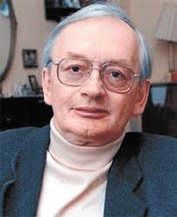
Alexei Starobinsky (photo from Wikipedia)
It appears that the enigmatic query is resolved by the same natural force that bestowed upon our planet its spherical form – gravity. However, it manifests not in its attractive guise, but rather in its repulsive manifestation.
Undoubtedly, this marked a significant breakthrough. We dare to label it as the second revolution in cosmology, which unfolded during the early 1980s across several progressive stages that we shall delineate in accordance with their chronological order.
Back in 1980, Alexei Starobinsky proposed the first detailed version of the inflation mechanism. This mechanism was based on modifying Einstein’s equations, specifically in the context of huge spacetime curvatures. The modification involved adding a term that was proportional to the square of the curvature of spacetime. The inspiration for this modification came from quantum field theory. It’s similar to the Casimir effect, where metal plates cause fluctuations in the electromagnetic field in a vacuum. In Starobinsky’s model, the fluctuations of the vacuum fields are affected by the large spacetime curvature. This leads to an increase in vacuum energy, unlike the Casimir effect where it decreases. This increase in energy corresponds to the presence of a scalar field that pushes space gravitationally. On the other hand, this effect is equivalent to the lambda term in Einstein’s equations, except in this case, it’s not constant and becomes negligible when the accelerated expansion of the Universe stops.
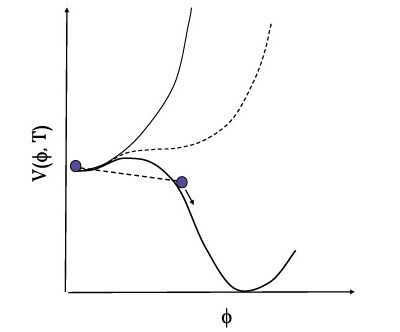
Figure 19.2. The Alan Guth scenario showcases the potential of the inflaton field. The various curves depicted in the figure illustrate the variations in temperature.
After analyzing the past, it has been discovered that Starobinsky’s model is essentially identical to the more recent and most accurate strong-field inflation model (slow roll-off scenario). Unfortunately, when it was first introduced, this research did not receive the recognition it deserved. Several factors are mentioned, including the isolation of Soviet science during that time. However, the article was published in a reputable international journal and received significant citations afterwards. Additionally, with the new information on relic radiation, Starobinsky’s model, combined with the work of V. Mukhanov and G. Chibisov (refer to the section below), has become one of the top contenders. Now, with the publication of the final data from the WMAP space microwave telescope and the analysis of various data collected by different instruments, it is evident that this model fits into the overall understanding of the subject better than many others.
Starobinsky’s work has finally gained well-deserved recognition. Did Alexey himself fully understand the significance of his work? The paper itself does not explicitly state that this mechanism allows us to solve the main problems of cosmology. However, it would be best to inquire about this closer to the end of the book.
Alan Guth, who published a paper with a different mechanism of cosmological inflation later in the same year, began making statements that inflation solves the main paradoxes quite explicitly and persistently. It was Guth’s paper that led to the emergence of a new paradigm. Perhaps it was not just the article itself, but also Guth’s intensive propaganda campaign, where he spoke at numerous conferences and seminars worldwide, convincing and imploring others.
Scientists frequently hesitate to disclose their findings prior to publication due to concerns of theft. Typically, this behavior is more common among less experienced researchers. While instances of actual theft do occur, they are relatively rare compared to cases where the findings are simply overlooked or ignored. This is especially true when the research opens up a new and unconventional direction or falls outside the purview of mainstream scientific interests. In such cases, actively promoting and disseminating new results within the scientific community is just as important as writing the actual research paper. Alan Guth has demonstrated proficiency in this aspect of the scientific process.
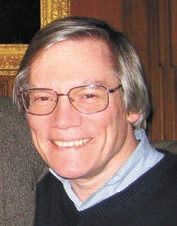
Alan Guth (image sourced from Wikipedia)
Alan Guth has proposed a scenario involving a scalar field that has both a metastable state and a ground state. This field is similar to the Higgs field but has a much higher energy density. It is believed that this scalar field is responsible for breaking the symmetry associated with the grand unification. However, we cannot directly detect or interact with this field. The detection of a scalar field typically involves exciting it and producing a field particle, as we have seen with the Higgs field. In the case of this hypothetical scalar field, its mass is so high that the possibility of its detection is unlikely. Nevertheless, there are strong arguments supporting the existence of such a field. For instance, the Grand Unification theory suggests that the energy scale of this field, represented by the characteristic potential V1, aligns well with the energy scales we observe in our current understanding of physics. We can see that the potential energy of this field is only a few orders of magnitude lower than the Planck energy.
The Guth scenario begins with a highly dense and extremely hot seed of the Universe. The origin of this embryo is a separate query that has been extensively debated. For instance, a microuniverse may emerge as a consequence of an infrequent (but not impossibly infrequent) quantum fluctuation. It is crucial that the seed expands (as per Friedman’s law) and that all fields are in thermodynamic equilibrium. The initial stage of the scenario lasts for a characteristic time of 10^-37 or 10^-36 seconds, during which the core has expanded and cooled down to 10^16 GeV. This is a significant moment because at this temperature, the field energy density φ becomes comparable to the particle energy density, and the effective field potential undergoes a new minimum. This marks the moment of phase transition.
However, the transition of the field to the new minimum is delayed – a phenomenon similar to the supercooling that occurs when water freezes. The field φ “settles down” and remains in the local minimum φ.1, where the field is zero and the potential V1 is significantly high. This state of the field is also known as the “false vacuum”. In Andrei Linde’s clever words, it can be referred to as the “heavy nothing”. As the field continues to cool down, the energy density of the static field gradually becomes dominant over the thermal energy density. Additionally, the pressure of a constant and uniform scalar field becomes negative. At a certain point, the total pressure within the early Universe undergoes a change in sign and becomes negative. This causes the Universe to undergo overcooling, with the scalar field becoming trapped in a local minimum and entering a metastable state. As the cooling process progresses, the pressure continues to become more and more negative until it eventually crosses the critical threshold of -1/3 ε.
Simultaneously, the rate at which any two points move away from each other exceeds the speed of light. This doesn’t contradict anything – the points exist in separate regions of space that are not causally connected, so no information can be transmitted between them. The limit on the relative velocity of objects in the special theory of relativity is a local principle. In a stationary universe, it is a global principle, but in an expanding universe, it is not. It is possible that causality is not permanently lost – in a slower expanding universe, it may be restored. However, during the exponential expansion stage, any given volume quickly breaks apart into numerous regions that are completely unaware of each other. What is significant, though, is that these causally unrelated regions share a common origin – they retain knowledge of the initial conditions they originated from.
Eventually, after a period of 10 to 35 seconds, the metastable field experiences a sudden increase in activity, releasing its stored energy into particles. How does this phenomenon occur? According to Guth’s theory, the field is able to tunnel through the potential barrier and transition to the ground state φ in certain locations0. This process leads to the formation of expanding bubbles that represent a new phase known as the true vacuum. As these bubbles collide, the original false vacuum diminishes, transferring its energy to the surrounding particles. Consequently, the Universe undergoes a reheating phase, causing a change in pressure and resulting in a positive pressure value. This exponential expansion eventually comes to an end.
In accordance with Friedman’s theory, the events occur once more, but this time the Universe possesses an immense size and nearly negligible curvature. It continues to expand at a decelerating rate and will continue to grow exponentially, having undergone various other transformations at its inception. Simultaneously, its existence is assured to be nearly eternal, or possibly even truly eternal.
This is the narrative of the origin of our Universe through the mechanism of cosmological inflation, which was the first to gain widespread recognition. However, in this narrative, there is one erroneous episode. It will be discussed below. Often, breakthroughs that revolutionize our understanding of the world contain elements that turn out to be incorrect: Columbus believed he had reached the outskirts of India, Copernicus thought the planets’ orbits were circular, Hubble initially miscalculated his constant by more than five times. Guth proposed a scenario for the birth of the universe that may not have been feasible in its exact form, but captured the essence. Therefore, before we delve into the subsequent, more accurate scenarios, let’s highlight the most significant points articulated by Guth in his groundbreaking article.
Now, let’s revisit the fundamental questions outlined in the previous section.
- Why is the Universe so uniform, despite the lack of causal connection between its observable regions in the initial moments?
What caused the parameters of the Big Bang to be so consistent across regions that were not causally connected? In the early stages of the universe, all observable parts were part of a single causally connected region before inflation occurred. Although this connection was lost, the shared past and the shared scalar field remained. The field, which underwent little change, expanded along with space, resulting in a uniform distribution by the end of inflation. The homogeneity of the field contributed to the homogeneity observed in regions that lost causal connection. - What is the reason for the abundance of particles in the Universe (approximately 10^90 in its visible part alone)?
Put simply, how did the Universe manage to have such a high level of entropy? Particles were generated through the decay of a scalar field, which became extremely large – as the Universe expanded, the field that filled it, unlike the gas of particles, maintained a consistent density. This meant that the total energy of the field during the inflationary stage grew exponentially. All of this energy transformed into particles. As the Universe continued to expand, the number of particles in a given volume remained relatively constant. Importantly, there was no violation of the law of conservation of energy: at any given moment, the negative gravitational energy of the Universe was equal in magnitude to the energy of the scalar field (and subsequently, the energy of the particles). Therefore, all the contents of the vast Universe seemingly came into existence “for free”. This is what sets the Universe apart from any object within it: the principle of conservation of matter does not apply globally – everything that exists in the Universe was essentially created out of nothing, contradicting the beliefs of the ancient Greeks and other classical natural scientists who regarded this as impossible. The vast contents of the Universe are laid out before us, and the fact that it was obtained through the abstract negative energy of the gravitational connection does not diminish the awe-inspiring nature of the process of creating everything out of nothing. - What caused the initial expansion of the universe?
The cosmological inflation scenario provides a detailed explanation of that initial push.
It’s actually quite straightforward
In 1982, there was a conversation in the FIAN canteen that Igor Tkachev vividly recalls. The full story of this conversation is worth sharing.
Igor Tkachev shares his experience of a lengthy discussion with Andrei Linde
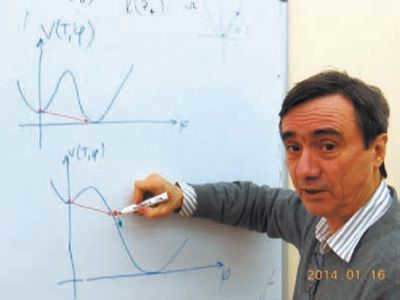
Figure 20.1. Igor Tkachev presents different scenarios for the inflaton tunneling transition – as proposed in Guth’s research (above) and the actual depiction of how it is expected to occur (at the bottom). Image by B. Stern
Andrei has made a calculation regarding the subsequent events – the process becomes even simpler to determine. It has been discovered that inflation does not cease at any point. The field continues to expand the space and manages to expand it exponentially until it eventually “slides” down the slope. This reveals some crucial findings: the Guth scenario is incorrect in its conclusion – the bubbles of the new phase, which tunnel through the barrier, do not have sufficient time to merge, blend, and heat up, thereby creating a homogeneous hot universe – instead, they disperse across vast distances. Additionally, this implies that there is no requirement to devise intricate potentials with a barrier. Inflation can function without them. These implications are highly significant, and Andrei, still somewhat skeptical of his findings, aimed to discuss them with as many colleagues as possible in order to garner support and confidence prior to publishing the paper.
Thus, the intention behind the creation of the potential barrier was to slow down the scalar field in the local minimum, allowing enough time for the universe to expand before the field “drops” into the ground state. However, it has been discovered that the field can become “stuck” near its initial value even without the barrier. In order for this to occur, the expansion must be rapid and the field potential must be flat. In terms of familiar phenomena, the swift expansion acts as a form of viscous friction, while the slope of the potential V(φ) is comparable to the slope of a surface on which a ball rolls. There are various ways to construct a scalar field. The suggested alternative to the Guth scenario, proposed by Andreas Linde and later by Andreas Albrecht and Paul Steinhardt three months later, involves a potential with a flat top at zero field and a minimum on the side, as illustrated in Figure 20.2.
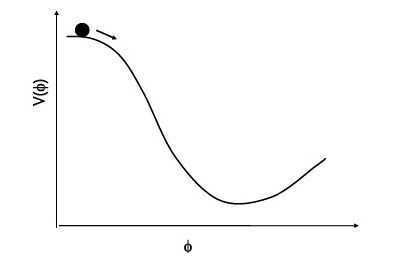
And even easier
Andrei Linde took the next significant stride forward, surpassing all other contenders. In reality, it can be made even simpler – inflation can happen without any gimmicks, such as a unique potential with a level peak at zero, and without a state of thermodynamic equilibrium with extreme cooling. Just take any field with a naturally-shaped potential resembling a cup.

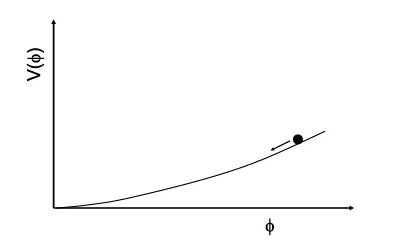
Fig. 21.2. The diagram illustrates the potential in the theory of chaotic inflation: the field is positioned on the gradient of the potential, but its descent is gradual enough for the universe to undergo a rapid expansion by several orders of magnitude.
Andrei Linde named this situation chaotic inflation because it only requires a suitable combination of various random initial conditions to initiate the process. However, it is important to note that the term “chaotic” only refers to the beginning. After that, everything progresses regularly and with a predictable outcome, similar to the previous scenario. The major advantage of this scenario is that it does not require thermodynamic equilibrium or a phase transition before inflation occurs. In the Guth and “new inflation” scenarios, the sequence of events was as follows: a hot universe, supercooling, inflation, and then a hot universe again. With chaotic inflation, the first two stages, which can be quite complex, are eliminated. There is no longer a need to explain how the pre-inflationary thermodynamic equilibrium was established (which may not be obvious), or to have a very specific type of potential, and so on. It can be said that chaotic inflation is currently the widely accepted concept for the origin of the Universe, or more precisely, a part of it.
Galaxies
What exactly is a galaxy? A galaxy is the fundamental building block of the Universe, consisting of approximately 150-200 billion stars, as well as various stellar systems composed of stars, gas and dust nebulae, and scattered interstellar matter.
While there are individual galaxies, they tend to prefer congregating in groups. These groups usually consist of around 50 galaxies and can span a diameter of 6 million light-years. The Milky Way group, for example, boasts over 40 galaxies.
Clusters, on the other hand, are even larger and can contain anywhere from 50 to 1000 galaxies, with diameters reaching 2-10 megaparsecs. What’s fascinating is that despite their immense sizes, these clusters maintain incredibly high velocities, indicating that they must overcome the force of gravity to stay together.
When discussing galactic clusters, the topic of dark matter often arises. It is believed that dark matter plays a crucial role in preventing galaxies from dispersing and keeps them bound together.
Sometimes, clusters unite and create a supercluster, resulting in the formation of some of the most massive structures in the universe. The most colossal one is the Sloan Great Wall, with dimensions of 500 million light-years in length, 200 million light-years in width, and 15 million light-years in thickness.

Black holes
What exactly are Black Holes? – These are celestial bodies whose existence is foreseen by Einstein’s theory of gravitation (also known as the general theory of relativity) as a consequence of the evolutionary changes that occur in extremely massive stars during the final stages of their life, resulting in an infinite gravitational contraction (gravitational collapse).
According to American physicist Nikodim Poplavsky, black holes can lead to alternate universes. Einstein theorized that matter collapsing into a black hole is compacted into a singularity. According to his equations, on the opposite side of the black hole exists a white hole, a celestial object through which only matter and light can escape. When paired, these holes create a wormhole, and anything that enters from one side and emerges from the other gives rise to a brand new world. In the early 1990s, physicist Lee Smolin put forth a similar and somewhat stranger proposition: he also posited the existence of universes on the other side of black holes, but he believed that they are subject to a law akin to natural selection, where they reproduce and mutate as part of their evolutionary process.

The dimensionality of the universe
For over a century, the issue of the dimensionality of the Universe has been the subject of intensive investigation. Numerous phenomena and groundbreaking experiments suggest that the observable physical world could potentially be just a subset of Hyperspace, forming a intricate “geometric formation” within it. The concept of our Universe as a multidimensional entity has been discussed in works such as “The Secret Doctrine” by E. Blavatsky.
The physical processes of our world, including the motion of celestial bodies, were described by scientists in Ancient Greece using the concept of enclosed concentric spheres. Based on these ideas, Aristotle developed the theory of homocentric spheres, which he gave a “physical” justification. According to this theory, celestial bodies are believed to be rigidly attached to a combination of interconnected rigid spheres with a shared center. The motion from the outer spheres is transmitted to the inner spheres. In the end, this theory did not gain popularity and was eventually abandoned (ironically, this theory aligns perfectly with the suggested process!).
The density of matter in the outer space surrounding the Sun is incredibly low, at 0.88-10-22 kg/m3. This minuscule density is more than a billion trillion trillion trillion times less than the density of water. It is fascinating to consider what forces and mechanisms are able to maintain the integrity and stability of stars and galaxies as they traverse through this seemingly empty expanse.
The arrangement of matter in the Universe
In the 1970s, a team of scientists from the Soviet Union and the United States, led by Academician Zeldovich, endeavored to create a three-dimensional representation of how matter is distributed throughout the Universe. To accomplish this, they inputted data on the distances to thousands of galaxies into a computer. The outcome was truly remarkable – galaxies, coming together in metagalaxies, were positioned in space as if they were on the periphery of a cellular structure with intervals of roughly 100 million light years. Within these cells, there was a noticeable absence of matter. In other words, the fabric of space and time exhibited a structured pattern! This discovery significantly challenged the credibility of the Big Bang theory and the Friedman model of the Universe.
Additional conjectures
In 1908, the French scientist Charlier proposed a theory suggesting that the Universe consists of a series of progressively larger systems. Stars come together to form star clusters, which then combine to create galaxies. These galaxies, in turn, form clusters of galaxies that make up a metagalaxy. According to this discrete self-similar cosmological paradigm, the sizes of these colossal stellar systems should continue to expand indefinitely. This concept highlights the hierarchical structure of natural systems, ranging from the tiniest observable elementary particles to the most massive visible galaxy clusters.
At the time, Charlier’s hypothesis was not widely accepted. This can be attributed to the emergence of the general theory of relativity, which captivated people with its unique concept of a universe that is both finite and unlimited. However, observational results had not yet provided compelling evidence to support the conclusions of the theory of relativity and the idea of a finite universe. The hypothesis of an infinite universe appeared to be more plausible. In this context, the Charlier model becomes particularly intriguing.
Indeed, the concept presented in the book discussing a system of enclosed spheres in space aligns with both the Charlier hypothesis and the discrete self-similar cosmological model. Additionally, as noted by Prof. G. Alven, the Charlier hypothesis provides an explanation for the Olbers paradox, which states that if galaxies are evenly distributed throughout the Universe, their collective radiation would be exceptionally intense, contrary to observations. Furthermore, Charlier’s hypothesis offers a solution to another issue related to the unusual increase in gravitational force caused by distant regions of space in a homogeneously distributed matter in the Universe.
According to the author of the monograph, the Universe ought to be regarded as a series of concentric spheres of growing magnitude, in accordance with the Charlier hypothesis. Furthermore, the question of the Universe’s nature would be meaningless without specifying the dimensionality of the space from which the observation is made.
Recently, this has been scientifically validated.
English physicist Roger Penrose from Oxford and his colleague Vahan Gurzadyan from the Yerevan Institute of Physics have discovered peculiar irregularities in the universe in the form of concentric circles after conducting a thorough examination of the relic radiation, also known as microwave background. This radiation, which has been preserved since the Big Bang, contains valuable information about the origins and evolution of the universe.

Scientists believe that the Universe is created in a sequential manner, one after another. The end of one universe marks the beginning of the next.
“In the future, our universe will revert back to the state it was in during the Big Bang,” claims Penrose. “It will become homogenous and go from infinitely large to infinitely small once again.” Interestingly, astrophysicists Paul Steinhardt from Princeton and Neil Turok from Cambridge share the same viewpoint.
In contemporary times, numerous new theories and hypotheses regarding the structure of the Universe have emerged, including the idea that “our Universe exists within a Universe with additional spatial dimensions.”
All of these illustrations serve as compelling evidence that the progression of any system, whether it be small or large, occurs through the expansion of the primary integral monad into its constituent material components. This expansion occurs through a series of developments, with each stage becoming more intricate than the previous, resulting in the formation of three interconnected realms. Furthermore, each subsequent dimension has its own designated area, within which the preceding dimension and its corresponding space are situated. For instance, a three-dimensional object that moves along the y-axis simultaneously experiences movement along its own developmental axis, the x-axis.
This implies that Nature exhibits resemblances in terms of forms and properties of structures, irrespective of their spatial magnitude, while the Universe is characterized as a multidimensional system organized in a hierarchical manner.
Are there any limits to the Universe?
Hence, the answer to the question of whether the Universe has limits also follows. According to the proposed theory of interconnected spaces, it becomes clear that the Universe does indeed have boundaries. However, these boundaries are so vast that they surpass the capacity of the human mind to comprehend. This aligns with the viewpoint of A. Einstein, who believed that the Universe is a closed hypersphere. Contemporary science regards the Universe as multidimensional, with our “local” three-dimensional Universe being just one layer among many. This perspective is also consistent with the theory of interconnected spaces.
This theory also provides an explanation for the paradox that arose during the movement of two spacecraft, “Pioneer-10” and “Pioneer-11”, which were the first in human history to venture beyond the confines of our solar system. It is puzzling that these spacecraft experienced braking, despite the fact that they were supposedly moving through a vacuum and there should have been no resistance. According to the hypothesis presented in the monograph, once they left the Solar System, the spacecraft entered a different realm, where the trajectory of their path is perpendicular. As a result, this new space exhibits completely different characteristics compared to the previous one.
Fun facts about the Cosmos
– The most remote stars that we are able to observe maintain their appearance from 14 trillion years ago. The light emitted by these stars traverses through space for billions of years, traveling at a speed of 300,000 km/sec.
– Enigmatic Black Holes are among the most intriguing and poorly understood entities in the Cosmos. Their gravitational force is so immense that nothing, not even light, can escape their gravitational pull.
– Within the vast expanse of the Universe, there exists a colossal gas-filled bubble. In universal terms, it emerged relatively recently, a mere two billion years after the occurrence of the Big Bang. This elongated bubble spans 200 million cosmic years, with a distance from Earth measuring 12 billion cosmic years.
– Quasars exhibit an incredibly luminous radiance (far surpassing that of the Sun).
– In the Solar System, there exists a celestial body similar to Earth. Titan, a moon of Saturn, boasts a surface adorned with rivers, volcanoes, seas, and a dense atmosphere. The distance between Saturn and its satellite is comparable to the distance between Earth and the Sun, and the mass ratio between the two bodies is also similar. However, the presence of methane and propane in Titan’s bodies of water makes the existence of intelligent life unlikely.
– Weightlessness experienced in space poses negative effects on human health. One of the notable changes that occur in the human body in a weightless environment is the loss of calcium from the bones, the upward displacement of fluids, and the impairment of bowel function.
The cosmos… That is a terrifying term. The vastness of what this term signifies is unfathomable. For us to journey 1000 kilometers is already a significant distance, and that pales in comparison to the astronomical value that denotes the absolute minimum, as per the perspective of scientists, of the diameter of our Universe.
This value is not merely immense – it is inconceivable. 93 billion light years! In kilometers, this equates to 879,847,933,950,950,014,400,000,000.
What is the nature of the cosmos?
The nature of the cosmos is an enigma that eludes complete understanding, as Kozma Prutkov once wrote. However, we can approach it by examining familiar and simple objects that help us conceptualize its vastness.
What constitutes our vast Universe?
To delve into this question, let’s go to the kitchen and grab a foam sponge that is typically used for washing dishes. Do you have it? Great, because what you’re holding is essentially a miniature representation of the universe. By examining the structure of the sponge under a magnifying glass, you will notice that it consists of countless interconnected pores, not unlike the cosmic expanse with its boundaries defined by lintels.
Expansion of the Universe
The expansion of the universe refers to the increase in the distance between galaxies over time. This concept is a fundamental aspect of modern cosmology and is supported by a large body of observational evidence.
One of the key pieces of evidence for the expansion of the universe is the observation of redshift in the light from distant galaxies. Redshift occurs when the wavelength of light is stretched as it travels through space, causing it to appear more red. This redshift is a result of the expansion of space itself, which causes the wavelengths of light to be stretched as they travel.
Another piece of evidence for the expansion of the universe comes from the observation of the cosmic microwave background radiation. This radiation is a faint glow of light that is left over from the early stages of the universe, when it was much hotter and denser. The patterns in this radiation provide strong evidence for the expansion of the universe and the Big Bang theory.
The expansion of the universe is thought to have begun with the Big Bang, a powerful explosion that occurred approximately 13.8 billion years ago. Since then, the universe has been expanding, with galaxies moving away from each other in all directions. This expansion is not due to galaxies moving through space, but rather to the stretching of space itself.
The rate of expansion of the universe is described by a parameter known as the Hubble constant. This constant is named after Edwin Hubble, who first discovered the expansion of the universe in the 1920s. The Hubble constant represents the rate at which the distance between galaxies is increasing, and is an important quantity for understanding the evolution of the universe.
In addition to the expansion of the universe, scientists have also discovered that the rate of expansion is accelerating. This discovery, made in the late 1990s, was unexpected and has led to the concept of dark energy. Dark energy is a mysterious form of energy that is thought to be responsible for the accelerated expansion of the universe.
Overall, the expansion of the universe is a fundamental concept in modern cosmology. It provides a framework for understanding the large-scale structure of the universe and how it has evolved over time.
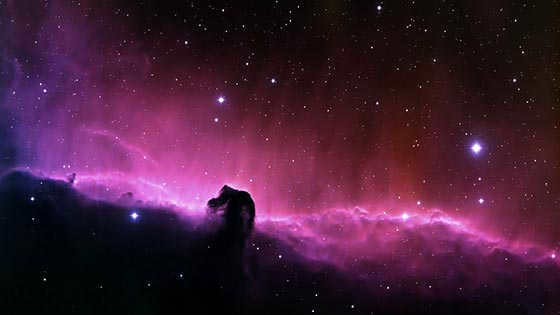
The Universe is not only vast, but it is also continually growing. The concept of redshift is what led to the development of the Big Bang theory.
As per NASA, the estimated age of the Universe since the occurrence of the Big Bang is around 13.7 billion years.
What is the definition of the term “universe”?
The term “universe” originates from Old Slavic roots and is a variation of the Greek word “oikumenta” (οḥṇ). This Greek word is derived from the verb “οἰκέω” meaning “to inhabit, to dwell in”. Initially, “universe” referred to the entire inhabited part of the world. In the realm of the church, it still carries a similar meaning. For example, the Patriarch of Constantinople includes the word “Ecumenical” in his title.
The term is related to the concept of “omnipresence” and is synonymous with the word “all”.
What lies at the heart of the cosmos?
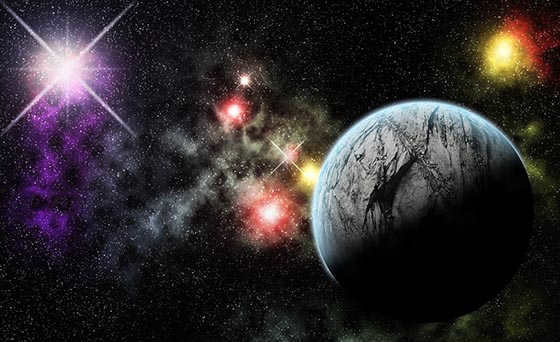
If there is not a distinct definition of the center of the Universe, discussing what exists in this particular center is a futile endeavor.
What lies beyond the center of the universe?
This question is highly intriguing, but just as uncertain as the previous query. The existence of boundaries for the universe remains unknown. It is possible that there are no limits, or perhaps there are. It is also possible that alongside our Universe, there exist others with distinct material properties, natural laws, and universal constants. No one can provide a definitive answer to such an inquiry.
What other information do we have regarding the cosmos?
